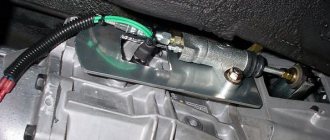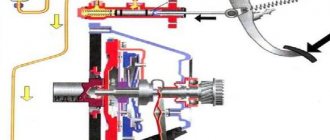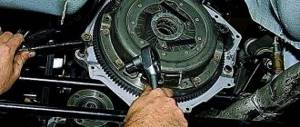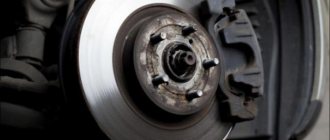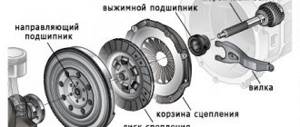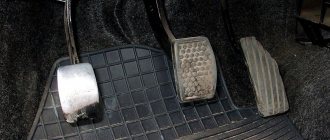Replacing clutch fluid on a VAZ 2101-VAZ 2107
Welcome! Clutch fluid - over time it becomes unusable like any other fluid, and therefore over time it needs to be changed, but not everyone knows how to do this, so especially for these people we have prepared this article, which describes in detail the replacement of fluid in the clutch hydraulic drive .
Note! To change the fluid in the hydraulic drive, you will need to stock up on: New brake fluid, and you will also need to take an assistant with you, so changing the fluid with him will be much easier, and you will also need any container into which the used fluid will be drained, and You will also need to stock up on a small hose about 0.5 meters long, with the help of which the fluid will be drained from the clutch hydraulic drive!
And also, to replace the fluid in the clutch, you need to stock up on: A clean or slightly dirty rag, and you will also need to take a basic set of wrenches, which will include small “8” and “10” wrenches!
What should be poured into the clutch hydraulic drive? We are often asked this question, and the answer is very simple. Only brake fluid should be poured into the clutch drive, because it does not compress, thereby not creating depressurization in the system, which in turn can lead to complete failure of the clutch.
Where is the clutch reservoir located? Many people very often confuse the clutch reservoir with the brake reservoir, and therefore, so that you never get confused in these nuances, we will explain it right away. The clutch reservoir has always been and is currently located on classics closer to the fender, so that you understand in more detail, in this case, look just below the photo in which the hydraulic reservoir is clearly visible and indicated by an arrow.
When do you need to change the fluid in the clutch reservoir? As was said a little earlier, over time, any fluid loses its properties and thus can no longer normally perform the function for which it was created, therefore it is recommended to change the fluid in the hydraulic drive after five years of operation of the car, or if it gets into the system air that should not be in the system, and thus you have to bleed the clutch system of the car and thereby also have to replace the brake fluid in the clutch tank with a new one. (For information on how to bleed the system, see the very bottom of the article in the “Important!” section, there will be a link to bleeding the clutch on a VAZ)
How to replace clutch fluid on a VAZ 2101-VAZ 2107?
Draining: 1) First, before you start working, use a clean or slightly dirty rag to wipe the clutch reservoir, or just its cover, to make it more pleasant to work with.
2) Next, grab the tank cap with your hand, and thereby completely unscrew it and put it aside so as not to lose it.
3) Next, if the crankcase protection installed on your car bothers you, let’s say it’s too big, then remove it to gain access to the clutch slave cylinder. (For information on how to remove the protection, see the article: “Replacing the crankcase protection”)
4) Now perform the following operation, to do this, again using a cloth, wipe the protective cap located on the fitting of the clutch slave cylinder and at the same time clean the cylinder fitting itself from dirt.
5) After the dirt has been removed, take a wrench and use it to unscrew the fitting itself by about 3 or 4 turns (At your discretion), and after unscrewing the fitting, at this time let your assistant help you, thereby pressing the pedal clutch several or even more times, generally until all the fluid flows into the container you prepared in advance.
Note! When pressing the pedal, be sure to warn the assistant that it may fail, that is, fall to the very bottom and not go back, then in this case, let him return the pedal to its place with his hand, bending it to do this and thereby lifting it!
Filling: 1) When all the liquid has been drained from the tank, then in this case tell the assistant that you don’t need to press the pedal anymore, and at this time you tighten the bleeder fitting that was unscrewed earlier so that the liquid no longer pours out of the working cylinder and always remained in it.
Note! At the very end of the operation, fill the clutch hydraulic reservoir with brake fluid to the required level!
And after pouring the liquid before screwing the lid, visually inspect this lid for defects, and also check the compensation cavity, which is indicated by the arrow and which is also removed from the lid, so if after removal you see signs of rubber aging, signs of cracks and tears, then In this case, replace this cavity with a new one!
Advice! By the way! You can also replace the fluid in the clutch drive, displacing the old one, to do this you need to ask your assistant to add fluid to the reservoir as it is displaced, and do all this until normal, clean fluid begins to flow into the container you are holding!
Important! Be sure to bleed the car’s clutches when you finish replacing. (For information on how to bleed the drive, see the article: “Bleeding the clutch on a VAZ”)
vaz-russia.com
What kind of fluid should I put in the clutch reservoir?
Welcome! Clutch fluid - over time it becomes unusable like any other fluid, and therefore over time it needs to be changed, but not everyone knows how to do this, so especially for these people we have prepared this article, which describes in detail the replacement of fluid in the clutch hydraulic drive .
Note! To change the fluid in the hydraulic drive, you will need to stock up on: New brake fluid, and you will also need to take an assistant with you, so changing the fluid with him will be much easier, and you will also need any container into which the used fluid will be drained, and You will also need to stock up on a small hose about 0.5 meters long, with the help of which the fluid will be drained from the clutch hydraulic drive!
And also, to replace the fluid in the clutch, you need to stock up on: A clean or slightly dirty rag, and you will also need to take a basic set of wrenches, which will include small “8” and “10” wrenches!
What should be poured into the clutch hydraulic drive? We are often asked this question, and the answer is very simple. Only brake fluid should be poured into the clutch drive, because it does not compress, thereby not creating depressurization in the system, which in turn can lead to complete failure of the clutch.
Where is the clutch reservoir located? Many people very often confuse the clutch reservoir with the brake reservoir, and therefore, so that you never get confused in these nuances, we will explain it right away. The clutch reservoir has always been and is currently located on classics closer to the fender, so that you understand in more detail, in this case, look just below the photo in which the hydraulic reservoir is clearly visible and indicated by an arrow.
When do you need to change the fluid in the clutch reservoir? As was said a little earlier, over time, any fluid loses its properties and thus can no longer normally perform the function for which it was created, therefore it is recommended to change the fluid in the hydraulic drive after five years of operation of the car, or if it gets into the system air that should not be in the system, and thus you have to bleed the clutch system of the car and thereby also have to replace the brake fluid in the clutch tank with a new one. (For information on how to bleed the system, see the very bottom of the article in the “Important!” section, there will be a link to bleeding the clutch on a VAZ)
How to replace clutch fluid on a VAZ 2101-VAZ 2107?
Draining: 1) First, before you start working, use a clean or slightly dirty rag to wipe the clutch reservoir, or just its cover, to make it more pleasant to work with.
2) Next, grab the tank cap with your hand, and thereby completely unscrew it and put it aside so as not to lose it.
3) Next, if the crankcase protection installed on your car bothers you, let’s say it’s too big, then remove it to gain access to the clutch slave cylinder. (For information on how to remove the protection, see the article: “Replacing the crankcase protection”)
4) Now perform the following operation, to do this, again using a cloth, wipe the protective cap located on the fitting of the clutch slave cylinder and at the same time clean the cylinder fitting itself from dirt.
5) After the dirt has been removed, take a wrench and use it to unscrew the fitting itself by about 3 or 4 turns (At your discretion), and after unscrewing the fitting, at this time let your assistant help you, thereby pressing the pedal clutch several or even more times, generally until all the fluid flows into the container you prepared in advance.
Note! When pressing the pedal, be sure to warn the assistant that it may fail, that is, fall to the very bottom and not go back, then in this case, let him return the pedal to its place with his hand, bending it to do this and thereby lifting it!
Filling: 1) When all the liquid has been drained from the tank, then in this case tell the assistant that you don’t need to press the pedal anymore, and at this time you tighten the bleeder fitting that was unscrewed earlier so that the liquid no longer pours out of the working cylinder and always remained in it.
Note! At the very end of the operation, fill the clutch hydraulic reservoir with brake fluid to the required level!
And after pouring the liquid before screwing the lid, visually inspect this lid for defects, and also check the compensation cavity, which is indicated by the arrow and which is also removed from the lid, so if after removal you see signs of rubber aging, signs of cracks and tears, then In this case, replace this cavity with a new one!
Advice! By the way! You can also replace the fluid in the clutch drive, displacing the old one, to do this you need to ask your assistant to add fluid to the reservoir as it is displaced, and do all this until normal, clean fluid begins to flow into the container you are holding!
Important! Be sure to bleed the car’s clutches when you finish replacing. (For information on how to bleed the drive, see the article: “Bleeding the clutch on a VAZ”)
Greetings to all. I read how many people change fluids before winter and remembered that I have never changed the fluid in the steering wheel or clutch. There is no point in describing the power steering fluid, it’s already a tired topic, but in the clutch... I was horrified when I saw its color. It was decided to urgently change! I took a friend with me to bleed the working cylinder and got to work. It took about 15 minutes to do everything. The effect is noticeable! Now the clutch is a little easier to press and the gears engage without crunching. Especially the back!
Even after purchasing this car, there were not enough mirror caps in the interior. The previous owner was a jerk and broke both at once. But I still couldn’t get around to buying them. And so I decided. Moreover, the cost is adequate. 300 rubles for two triangles. Thank you for your attention, have a smooth road!)
Tools:
- Open-end wrench 10 mm
- Hose
- Transparent vessel
Parts and consumables:
According to the manufacturer's recommendation, the working fluid in the clutch release hydraulic drive should be replaced after 20 thousand kilometers or 2 years of operation (whichever comes first).
Note:
The hydraulic clutch release system uses DOT-3 or DOT-4 brake fluid. Brake fluid is very hygroscopic (absorbs moisture from the air). Condensate formed in the main and working cylinders causes corrosion and failure of the hydraulic drive. Therefore, we recommend replacing the working fluid every year (in spring) regardless of mileage.
Warning:
Do not reuse the drained liquid: it is contaminated, saturated with air and moisture. Always add only new fluid to the system of the brand that was filled before. Brake fluid is hygroscopic (absorbs moisture from the surrounding air), so it should not be stored in open containers.
Protect the environment! Do not dispose of used brake fluid into the soil or sewer system. You can find out about the location of waste fluid collection points in your area from your local authorities.
To replace the working fluid in the hydraulic clutch release drive of Nissan Almera Classic, you must do the following:
1. Fill the hydraulic clutch release reservoir with clean brake fluid to the top edge of the reservoir.
2. Remove the protective cap from the valve to bleed air from the clutch slave cylinder.
3. Place a hose on the valve and lower its end into a container with a small amount of brake fluid.
4. An assistant must sharply press the clutch pedal four to five times (with an interval between presses of 1–2 s), and then keep the pedal pressed.
5. Unscrew the air release valve 1/2-3/4 turn. Old (dirty) working fluid will begin to flow out of the hose. As soon as the fluid stops flowing, close the air release valve.
Note:
Constantly monitor the fluid level in the tank, not allowing it to drop to the “MIN” mark on the tank wall. If necessary, add new brake fluid to prevent air from entering the hydraulic drive. This ensures that the old fluid is gradually replaced by the new one without draining the hydraulic system.
6. Repeat steps 3-5 until the fluid in the drive is completely replaced (clean fluid without air bubbles should flow out of the hose).
7. After replacing the hydraulic fluid, be sure to put the protective cap on the air release valve.
8. Add brake fluid to the level of the “MAX” mark on the wall of the hydraulic clutch release reservoir.
9. Close the tank with a lid.
The article is missing:
- High-quality photos of repairs
womaninred.ru
Opel Astra H (Family) / Manual
According to the recommendation of the Opel Astra manufacturer, the brake fluid should be replaced after 2 years of operation or after 30 thousand km (whichever comes first).Recommendation
Brake fluid is very hygroscopic (absorbs moisture from the air), which, in addition to causing corrosion of brake system parts, lowers the boiling point of the fluid itself, and this can lead to brake failure during frequent heavy braking. Therefore, we recommend replacing the brake fluid every year.
Before replacing the brake fluid, check the tightness of the hydraulic drive (see Checking the tightness of the hydraulic drive of the brake system) and eliminate the faults.
You will need: a pipe wrench “10”, a wrench “17”, brake fluid, a rubber or transparent hose, a transparent container.
Note
This is what a special wrench for pipeline nuts looks like.
Recommendations
It is recommended to replace the brake fluid with an assistant, having previously installed the Opel Astra car on an inspection ditch, overpass or lift (there is no need to remove the wheels).
Use DOT-4 brake fluid.
The order of replacing brake fluid is:
- rear right;
- front left;
- rear left;
- front right.
Warnings
Do not reuse the fluid drained from the system: it is contaminated, saturated with air and moisture. Always add only new fluid to the system of the brand that was filled before. Brake fluid is hygroscopic (absorbs moisture from the surrounding air), so it should not be stored in open containers.
Protect the environment! Do not dispose of used brake fluid into the soil or sewer system. You can find out about the location of waste fluid collection points in your area from your local authorities.
1. Unscrew the master cylinder reservoir cap.
2. Fill the reservoir with clean brake fluid to the bottom edge of the filler neck.
Warning
Brake the car with the parking brake and install wheel chocks (“chocks”) under the rear wheels.
3. Clean the air release valves from dirt...
4. ...and remove the protective caps of the valves of the working cylinders of the rear brake mechanisms...
5. ...and the front wheels.
6. Place a rubber hose onto the rear brake wheel cylinder air release valve and immerse the end of the hose in a clean, transparent container.
7. An assistant must sharply press the brake pedal four to five times (with an interval of 1-2 seconds between presses), and then keep the pedal pressed.
8. Unscrew the air release valve 1/2-3/4 turn. Old (dirty) brake fluid will begin to flow out of the hose. At this time, the brake pedal should smoothly reach the stop. As soon as the fluid stops flowing, close the air release valve.
Note
Constantly monitor the fluid level in the tank, not allowing it to drop to the “MIN” mark on the tank wall. If necessary, add new brake fluid to prevent air from entering the hydraulic drive. This ensures that the old fluid is gradually replaced by the new one without draining the hydraulic system.
9. In the same way, replace the brake fluid in the working cylinder of the brake mechanism of the left front wheel.
10. Then replace the brake fluid in the second circuit (first in the working cylinder of the brake mechanism of the left rear wheel, then the right front).
11. Repeat steps 6-8 until the fluid in the drive is completely replaced (clean fluid without air bubbles should flow out of the hose).
12. After replacing the brake fluid, be sure to put the protective caps on the air release valves.
13. Check the quality of the work done: press the brake pedal several times - the pedal travel and the force on it should be the same with each press. If not, go back to steps 6-8.
14. To replace the brake fluid in the hydraulic clutch release drive, remove the protective cap from the valve to remove air from the working cylinder.
15. Place a hose on the valve and lower its end into a container with a small amount of brake fluid. Have an assistant press the clutch pedal 4-5 times at 2-3 s intervals and then hold it down. Turn the fitting out 3/4 of a turn, holding the adapter with a second wrench to prevent it from turning. Old (dirty) brake fluid will flow out of the hose into the container.
16. Close the valve and ask an assistant to release the clutch pedal.
17. Repeat operations 14 and 15 until the fluid in the clutch release hydraulic drive is completely replaced (clean fluid without air bubbles should flow out of the hose).
Warning
While bleeding the hydraulic drive, periodically check the fluid level in the master brake cylinder reservoir, which is common for the brake and clutch hydraulic drives. Do not allow the liquid level in it to drop below the “MIN” mark. Add fluid in a timely manner, otherwise air will get into the system and it will have to be pumped.
18. Close the valve and put on the protective cap.
19. Add brake fluid to the level between the “MIN” and “MAX” marks on the wall of the reservoir and tighten the cap.
20. Install the parts in the reverse order of removal.
Replacing fluid in the clutch hydraulic drive is a guarantee of safety
One of the main conditions for safe driving is the reliability of the braking system. For this reason, brake fluids are subject to fairly stringent requirements. During operation, their characteristics can significantly decrease, which leads to the need for complete replacement at the frequency specified by the manufacturer.
Why do you need brake fluid?
When you press the brake pedal, the cylinder is compressed by filling it with liquid. This, in turn, is supplied to the caliper under high pressure. As a result, the vehicle speed drops and movement slows down.
Often, during maintenance, car owners may be told that the clutch brake fluid needs to be replaced. You can do this yourself, which will allow you to save a lot on service station services. The brake system should be checked at least twice a year.
The service life of brake fluid is, for the most part, strictly limited and regulated by the manufacturer. It is advisable to change it twice a year in the spring. During replacement, it is advisable not to neglect banal safety rules.
Requirements for clutch brake fluid
Except for the basic requirements - viscosity and boiling point - brake fluids must also meet some others:
- No negative impact on rubber parts. Rubber cuffs are located between the hydraulic drive pistons and cylinders. The tightness of these connections increases provided that the rubber increases in volume under the influence of brake fluid by no more than 10%. After pouring the composition, such parts should not lose strength, ductility, or deform.
- Lubrication of friction pairs. The level of wear of pistons, brake cylinder surfaces and lip seals depends on the lubricating properties of the composition.
- Resistance under the influence of temperature changes. In the range from -40°C to +100°C, clutch brake fluids must maintain their performance properties, not delaminate, and not settle on components and parts.
The composition should be replaced on average once every 2-4 years, and the frequency depends on the condition of the brake system and the car as a whole. Simply put, the older the vehicle, the more often it is advisable to change the brake fluid. If the composition changes color before the deadline, it is changed immediately.
We recommend watching this video about bleeding the clutch:
Replacing brake fluid
To replace the car clutch, you will need a second person, a 10-size wrench and several items:
- A syringe or rubber bulb.
- A container into which used brake fluid from the clutch and hydraulic drive will be drained.
- A vinyl tube with a diameter of 4-5 mm, can be taken from a dropper.
- Fresh brake fluid. At least a liter and a half.
- An overpass or inspection hole is not necessary, but is desirable, since it greatly facilitates and simplifies the replacement process.
The brake fluid in the clutch and hydraulic drive of the car is replaced as follows:
- Use a key of 10 to drain the used auto fluid from the system. The likelihood that air will get into the clutch or hydraulic drive is high, so they are not completely emptied. Fresh fluid is poured into a special container of the car to the level indicated on the body.
- A new hose is attached to the bleeding hole, and at the bottom there is a container into which the waste liquid will be drained.
- The second person must press the brake pedal several times until it fails, after which it is held in this state. During this time, it is necessary to unscrew the bleeder fitting and release the liquid. After the pedal is fully pressed to the floor, the fitting returns to its place and the brake is released.
The whole process is repeated at least ten times with each wheel until fresh fluid begins to flow when drained. It is easy to distinguish by its light color. The fitting is screwed on and the container is filled with fresh composition.
- Bleeding with other calipers is carried out according to a similar scheme in a certain order: first the right rear, then the left rear, right front and left front caliper.
Video about replacing fluid:
Possible malfunctions and deterioration in the performance of the clutch and brake system after replacing the TJ
Modern types of brake compounds can be mixed, but there are strict restrictions. This rule applies only to those auto fluids that meet the same characteristics. However, it is worth considering the fact that products from different manufacturers may have not only different manufacturing recipes, but also different bases. For this reason, you should not allow fluids to mix, since after replacing them the brake system may fail.
A change in shade is one of the main signs that the composition needs to be replaced. It does not indicate the presence of detergent additives, which is applicable for motor oils, but rather contamination with dust particles and wear products. If you do not change the clutch fluid and the hydraulic fluid for a very long time, then irreversible changes may begin in it, for example, an increase in viscosity. All this can cause jamming of the brake cylinders, brake failure and clutch failure. Varnish-like deposits may appear on internal parts and components of the system. It is advisable to change the darkened fluid immediately, without waiting for the end of its service life.
Fluid replacement must be done not only in a timely manner, but also correctly. When bleeding the brake system, old fluid is replaced with new fluid without air bubbles. To carry out this procedure, a volume of composition exceeding the volume of the container by one and a half times is sufficient. If air gets into the system, the brake pedal will operate the second or third time. Bleeding is carried out until the pedal becomes hard and stops at the same point.
It is advisable to use brake fluid only that recommended by the car manufacturer. When purchasing this composition, it is necessary to accurately check all specifications and characteristics.
The key to the durability and performance of the brake system is timely replacement of the fluid. If you purchase a used car, it is better to immediately replace it and bleed the entire system according to the regulations established by the manufacturer.
pro-zamenu.ru
Replacing the working fluid in the hydraulic clutch release drive of Mitsubishi Lancer 9
Auto News
AvtoVAZ spoke about the future of Lada Vesta and Xray
As for the possible appearance of a Vesta hatchback or coupe, then, according to the press service, these projects are economically unprofitable.
As for the Lada Largus, which has been produced by AvtoVAZ since 2012, the station wagon has been in need of restyling for a long time. 31 Oct 2020 10:57:57 +0000
Hyundai leads in January-September in sales in the segment of SUVs and crossovers in the Russian Federation
Based on the results of nine months of 2020, the leader in the sale of new cars in the SUV segment (SUVs and crossovers) is Hyundai - from January to September, about 73 thousand of these cars of this brand were sold in Russia. This was reported by the press service of the analytical agency Autostat.
31 Oct 2020 22:14:42 +0000
In St. Petersburg, sales of used cars with high engine power increased by a third
Sales of used cars with a capacity of more than 250 horsepower in St. Petersburg and the Leningrad region in the third quarter increased by 33% compared to the previous quarter and by 15% compared to the same period last year. Avito Auto experts report this.
30 Oct 2020 08:52:56 +0000
The updated Toyota RAV4 and the old Chevrolet Tahoe were combined into one model
A new model from Mitsuoka has appeared on the Japanese domestic market. A local company in Japan, Mitsuoka, has released its first SUV, called Buddy. The new product is based on the popular model - Toyota RAV4, although the manufacturer does not focus on this.
30 Oct 2020 10:10:35 +0000
New Nissan Pathfinder shown in first images
Photos of the updated Nissan Pathfinder SUV have been published on the Internet. These pictures are based on the concept of the Japanese brand. The Japanese company has been producing the Nissan Pathfinder car since the mid-80s in a three-door version, with five doors since 1989.
30 Oct 2020 15:17:32 +0000
The new Renault Koleos crossover has left the Russian market
It has become known that sales of the Renault Koleos model in our country have officially ended. However, at the moment there are no plans to resume deliveries of the vehicle to the Russian market. From now on, Renault will sell only locally produced cars and crossovers in Russia.
30 Oct 2020 16:21:07 +0000
Experts named 5 habits of drivers that kill the engine
Some drivers do not change the engine oil and do not monitor its level at all. Experts advise not to rely on the built-in oil pressure sensor, which will only signal when the engine is already experiencing oil starvation.
30 Oct 2020 07:47:00 +0000
Production of the fourth generation Skoda Octavia has begun in Russia
The updated fourth generation Skoda Octavia began production in Nizhny Novgorod. Now there is already a plant in operation where the Skoda Octavia is assembled using a full cycle (CKD) and includes: welding and painting.
31 Oct 2020 14:25:46 +0000
Motorists were named the main “consumables” that need to be changed regularly
Many drivers know about the need to regularly change engine oil, filters and brake fluid, but do not even think about the existence of other consumables, experts say. However, if you forget about them, you will have to face expensive repairs.
31 Oct 2020 12:20:15 +0000
AvtoVAZ began sales of new versions of Lada Xray Cross and 4×4
AvtoVAZ continues to expand the range of models in a special configuration called [BLACK] - on October 30, sales of 4x4 and XRAY Cross in this version began. Let us remind you that earlier in October sales of Vesta Cross and Vesta SW Cross in a special version already started.
31 Oct 2020 10:18:32 +0000
Automaker Genesis introduced the new GV70 crossover
The Genesis brand has kept the technical characteristics of the new GV70 secret for now. The South Korean brand Genesis showed the exterior and interior of its second crossover in the lineup - the GV70.
30 Oct 2020 08:07:38 +0000
Checking the fluid level in the clutch hydraulic reservoir | VAZ
Lada Xray. Checking the fluid level in the clutch hydraulic reservoir
The supply of hydraulic clutch brake fluid is located in the reservoir located on the left side of the front panel.
With the cap installed, the brake fluid level in the reservoir should reach the lower edge of the filler neck.
With the reservoir cap removed, the liquid level should reach the upper edge of the reservoir clamp. An increase in the fluid level in the clutch hydraulic reservoir indirectly indicates (with a sealed hydraulic drive) significant wear on the clutch driven disc linings.
To add brake fluid to the reservoir, turn it counterclockwise...
and remove the tank cap.
Add DOT-4 fluid to the reservoir to the required level.
Replace the lid, screwing it tightly.
If brake fluid gets on your car's paintwork, plastic parts, or wiring, it can cause damage. Remove it immediately with a clean cloth
Lada Xray. Bleeding the clutch hydraulic drive, replacing fluid
We pump the clutch hydraulic drive to remove air from it after it is depressurized when replacing the master cylinder, slave cylinder, hoses, tubes, as well as in case of replacing the working fluid. We remove air from the hydraulic drive when the engine is not running. Before pumping, check the fluid level in the clutch hydraulic reservoir and, if necessary, add fluid (see “Checking the fluid level in the clutch hydraulic reservoir,” page 35). We bleed the hydraulic drive with an assistant.
Remove the protective cap from the working cylinder bleeder fitting.
Using an 8-mm spanner, loosen the tightening of the bleeder fitting. We put a hose on the fitting, and immerse its free end in a container that is partially filled
working fluid.
Using the “8” wrench, unscrew the bleeder fitting 1/2-3/4 of a turn.
The assistant sharply presses and smoothly releases the clutch pedal several times until the air bubbles coming out of the hose disappear. In this case, it is necessary to monitor the fluid level in the tank and top it up. With the clutch pedal pressed, tighten the bleeder fitting.
We remove the hose, wipe the bleeder fitting dry and put a protective cap on it.
If air cannot be removed, check the tightness of connections, pipelines, hoses, master and working cylinders. We tighten leaking connections, replace faulty main and working cylinders (see “Clutch”, p. 170). We replace the working fluid in the clutch hydraulic drive in accordance with the maintenance regulations - after three years.
When replacing, pump out the old fluid from the tank with a syringe or rubber bulb.
Fill the reservoir with new fluid. We pump the clutch hydraulic drive until new fluid (lighter than the old one) begins to come out of the slave cylinder bleeder fitting.
After pumping, bring the fluid level in the clutch hydraulic reservoir to normal (see “Checking
fluid level in the clutch hydraulic reservoir", p. 35).
Video on the topic “Lada Xray. Checking the fluid level in the clutch hydraulic reservoir"
HOW TO BLEED THE CLUTCH QUICKLY AND WITHOUT ASSISTANT!!!
add power steering fluid to the reservoir opel astra h
carmanuals.ru
What to fill in the clutch reservoir of a VAZ 2107 - AutoTop
CLUTCH FLUID
LEVEL CHECK
• Make sure the fluid level in the reservoir is between the “MIN” and “MAX” marks when the engine is cold.
• Visually check for fluid leaks around the reservoir.
• If the fluid level is extremely low (below the MIN mark), check for fluid leaks from the clutch system.
BLOWING PROCEDURE
Note: Do not use a vacuum or mechanical device to bleed the hydraulic drive, as such devices will not completely remove air from the system.
Attention:
• Monitor the fluid level in the reservoir and do not allow it to empty.
• Do not spill clutch fluid on painted surfaces. If liquid is spilled, wipe it up immediately and rinse the area with water.
• Bleed the coupling (1).
1. Fill the reservoir with fresh clutch fluid.
2. Connect the clear vinyl hose to the bleeder fitting on the coupling.
3. Slowly press the clutch pedal all the way 15 times and release it at intervals of 2-3 seconds and keep it pressed.
4. Press the locking pin (1) of the coupling (2) and lock it in this position,
Caution: Keep the pedal depressed to prevent the tube from moving away from the coupling when applying pressure to the tube.
5. Slide the clutch tube (1) in the direction shown by the arrow.
Dimension "A": 5 mm
2: Clutch housing
Dimension "A": 10 mm
6. Quickly press the clutch pedal and keep it pressed. Then release the air from the tube.
Caution: Keep the pedal depressed to prevent the tube from moving away from the coupling when applying pressure to the tube.
7. Return the clutch tube (1) and locking pin to their original position.
8. Release the clutch pedal and wait 5 seconds.
9. Repeat pp. 3-8 until there are no air bubbles in the clutch fluid.
In the Service, Maintenance, Tuning , answer the question What kind of fluid should be poured into the hydraulic clutch release reservoir? ? VAZ 2107 and what is this tank for? asked by the author Bloodsucking The best answer is that brake fluid must be poured there in order for this very clutch to “disengage”
Last year I had to add brake fluid to the clutch reservoir several times. I tightened the clamp more tightly and the problem disappeared.
I recently discovered that the clutch pedal travel has changed a lot. I had to go to work, so I moved it carefully. After a day of work I started watching. The result is that the tank fitting on which the hose is attached broke off. The tank was empty - the liquid had leaked out. I got to the garage, removed the tank, disconnected the hose, and took the fitting out of it. I bought a new tank, filled it with fluid + installed a new clamp, because... the old one died!
autotop.info
Clutch, gearbox, transmission Lada Vesta
Products from the Dustershop77 range on the topic of the article:
| Name | Manufacturer | Price | Availability | Add to cart |
| DC952-7703062062 | Gasket for gearbox drain plug, transfer case Renault Duster / Terrano / Captur original 7703062062 | Original | 200 / 150 rub. Discount: 100 rub. | 2 |
| DC524-302054100R | Clutch kit for 1.6 (H4M) 4×2 gearbox JR5 (5-speed) original art. 302054100R | Original | 7500 / 6900 rub. Discount: 6500 rub. | 1 |
| DC422-510009710 | Release bearing for 1.6 (H4M) 4×2 gearbox JR5 / JH3 (5-speed) LUK 510009710 (306200650R / 7701478631 / 8200046103 / 8200764613 / 8200990502 / 306205482R / 306 205482R / 306206219R / 306201586R) | Analogue | 4500 / 3900 rub. Discount: 3500 rub. | 1 |
| DC383-ASAM-30799 | Gear shift lever bushing ASAM-SA 30799 original art. 7700732903 | Analogue | 400 / 150 rub. Discount: 100 rub. | 2 |
| DC440-8200410813 | Drive shaft retaining ring original art. 8200410813 | Original | 500 / 300 rub. Discount: 250 rub. | 2 |
| DC956-7700102458 | Automatic transmission filter DP2 original 7700102458 | Original | 900 / 600 rub. Discount: 500 rub. | 1 |
| DC1560-8200884113 | Drive oil seal original Renault 8200884113 left | Original | 1000 / 800 rub. Discount: 700 rub. | 3 |
| DC950-321031MG0B | Rear gearbox filler plug Renault Duster / Captur / Nissan Terrano 4x4 321031MG0B | Original | 1000 / 800 rub. Discount: 700 rub. | 1 |
| DC1316-8201630012 | Guide (tool) for centering the clutch and release (H4M-JR5/JH3) original 8201630012 | Original | 2000 / 1800 rub. Discount: 1600 rub. | 1 |
| DC1667 | Clutch kit Vesta (1.6l 21129 + manual transmission VAZ / AMT) LUK | Analogue | 5500 / 4500 rub. Discount: 4100 rub. | 1 |
| DC1630-7703075180 | Filler plug for gearbox / transfer case original 7703075180 | Original | 200 / 150 rub. Discount: 100 rub. | 1 |
| DC1631-8200201381 | Transmission/transfer case filler plug gaskets original 8200201381 | Original | 500 / 350 rub. Discount: 300 rub. | 1 |
Filling the clutch release hydraulic system with working fluid
Only special brake fluid is poured into the clutch release hydraulic drive system (TU MXP 1608-47, TU 35-ХП-430-62 or TU 35-ХК-482-64).
You cannot mix brake fluids of different brands and add to the system even the smallest amount of mineral oils, glycerin, gasoline, kerosene or mixtures thereof, which cause swelling and then complete destruction of rubber parts and, as a result, failure of the system. The use of ethylene glycol is also unacceptable due to the corrosion it causes to metal parts.
If special brake fluid is not available, you can use a mixture of 50% (by weight) castor oil and 50% butyl alcohol. It is possible to replace butyl alcohol with isobutyl or ethyl alcohol. It is important to keep in mind that ethyl alcohol evaporates more easily than butyl alcohol, and the composition of the mixture will change (especially in hot weather).
When switching to a different type of working fluid, it is necessary to remove the old one and thoroughly rinse the entire hydraulic clutch system with alcohol or new brake fluid. Brake fluid is poured into the body of the nutrient tank 3 without removing the strainer 2 from it in order to avoid foreign impurities entering the system. The brake fluid level should be 10-15 mm below the top edge of the reservoir.
It must be remembered that brake fluid leaves stains on the painted surface of the car body; therefore, you need to fill the system carefully, avoiding liquid getting on the body.
It is very easy to monitor the liquid level in the nutrient tank, since the tank is made of translucent plastic.
It is necessary to fill the hydraulic clutch release system with brake fluid and remove air from it in the following order:
- Fill the reservoir with liquid through a strainer to the normal level. To fill the tank faster, it is recommended to slightly raise the strainer.
- Clean the air release valve on the working cylinder from dust and dirt and, having removed the rubber protective cap 2 from the valve head, put a rubber hose (included with the car) on the valve head. Immerse the free end of the hose in brake fluid poured into a clean glass container with a capacity of at least 0.5 liters, which must be filled to half its height.
- Press the clutch pedal sharply with your foot 4-5 times in succession (with an interval of 1-2 seconds between presses), and then, leaving the pedal pressed, unscrew the air release valve 1/2-1 turn. Under the influence of the pressure created in the system, part of the liquid and the air contained in it will be released through the hose into the container with the liquid (the air will come out of the hose in the form of bubbles).
- After the liquid flows out of the hose stops, turn the air release valve all the way.
- Repeat operations 3 and 4 until the release of air from the hose immersed in a vessel with liquid completely stops (this will require up to 75-80 pedal presses).
During the operation of removing air from the hydraulic drive system, add brake fluid to the nutrient tank, preventing the level in it from decreasing by more than 2/3 of the normal value. Insufficient height of the liquid column above the bypass and compensation holes in the master cylinder body can lead to atmospheric air being sucked into the cylinder (and into the system).
After air bubbles stop coming out of the hose, keep the pedal pressed, turn the air release valve all the way, and only then remove the hose from its head. Next, put the protective cap on the valve head, add liquid to the tank to the normal level and replace the tank cap.
After bleeding is completed, wipe the surfaces of the clutch hydraulic drive parts with a cloth.
To completely fill the hydraulic clutch system, 150 g of brake fluid is required.
The brake fluid released into the vessel when pumping the system can be reused to refill it only after it has settled (at least 24 hours) and the air has been completely removed from it, then it must be filtered.
The quality of the system pumping should be judged by the full stroke of the clutch slave cylinder piston rod when pressing the clutch pedal all the way to the rubber mat of the body floor.
With a fully pumped system, the stroke of the piston rod, as indicated above, must be at least 10 mm. With a smaller amount of rod movement, if the system is in good condition and the full stroke of the clutch pedal is at least 150 mm, pumping should be continued, as indicated above, until air is completely removed from the system and normal stroke of the piston rod is obtained.
A properly pumped hydraulic clutch system should ensure shock-free engagement of first gear in the gearbox.
If, when the clutch pedal is pressed all the way, there is a shock engagement of the first gear, you should make sure that the free play of the outer end of the clutch release fork is installed correctly and that the clutch mechanism is in good condition.
ustroistvo-avtomobilya.ru
